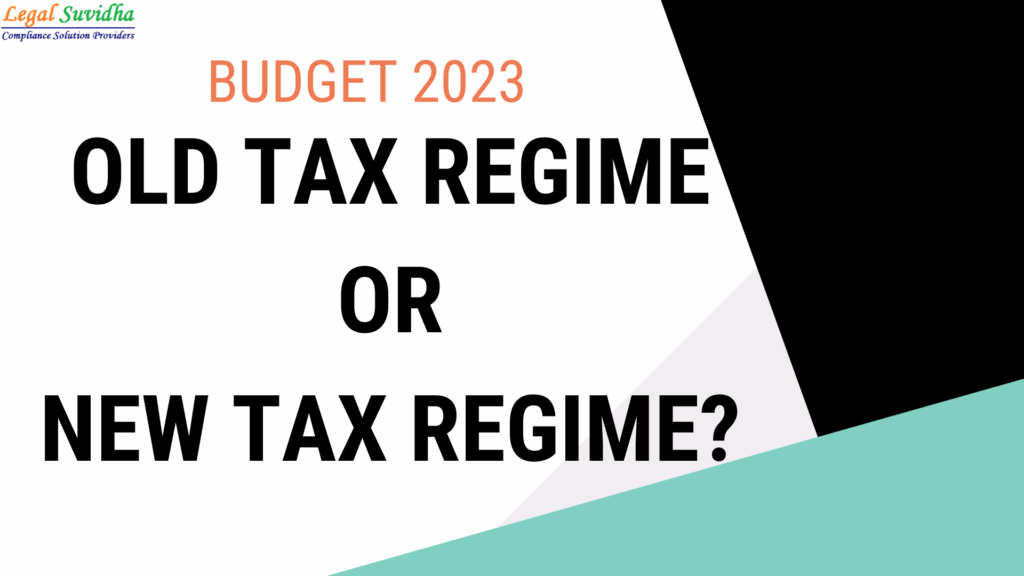BUDGET 2023: OLD TAX REGIME OR NEW TAX REGIME
In the Budget 2023, Finance Minister Nirmala Sitharaman proposed to make the new income tax regime the default tax regime for taxation purposes. However, taxpayers will continue to have the option to avail the benefit of the old tax regime. This means, if an employee does not opt for the old tax regime, the employer will have to apply tax slabs and rates applicable under the new tax regime to calculate tax deduction at source (TDS) while making salary payments. If one wants to continue with the old tax regime, going forward they have to opt for it.
The government introduced the new income-tax regime for taxpayers a couple of years back. However, it is still a dilemma for many individual taxpayers when it comes to choosing between the old and new income tax regimes.
Since the new concessional tax regime’s implementation in budget 2020, only some taxpayers have switched to it. The majority of people are still using the previous tax system.
Changes Announced in Union Budget 2023-24
With multiple significant changes announced in the budget for 2023, including the introduction of a standard deduction of Rs 50,000, an increase in the basic tax exemption limit to Rs 3 lakh, adjustments to the tax rates, and a reduction in the highest surcharge rate, all under the new tax regime, the scales have undoubtedly turned in favor of this regime.
The basic income tax exemption ceiling has been increased from the present level of Rs 2.5 lakh to Rs 3 lakh under the new tax system. The existing 25% tax bracket has been eliminated, and there are now just five tax slabs instead of six. For instance, people with taxable incomes between Rs 12.5 and Rs 15 lakh rupees came into the 25% tax bracket (pre-budget new tax regime). Now, people with taxable incomes above 12 to 15 lakh rupees would be subject to a 20% tax rate. For those under the previous tax system, nothing has changed.
OLD TAX REGIME OR NEW TAX REGIME?
Currently, neither the Old nor New tax regime requires anyone with an annual income of 5 lakh rupees to pay any income tax. This is after deducting the Rs 12,500 refund provided by Section 87A of the Income Tax Act.
Rs 25000 rebate shall be applicable to those who hold an income of more than Rs 7 lakh under the new tax regime. Nirmala Sitharaman in her budget speech addresses that “Persons in the new tax regime, with income up to Rs 7 lakh will not have to pay any tax,”
SLAB RATES OF THE NEW TAX REGIME ARE:
a. Rs 0-3 lakh – no tax
b. Rs 3-6 lakh – taxed at 5 percent
c. Rs 6-9 lakh – taxed at 10 percent
d. Rs 9-12 lakh – taxed at 15 percent
e. Rs 12-15 lakh- taxed at 20 percent
f. Above ₹ 15 lakh – taxed at 30 percent
Below is an example of how the new tax regime :
If your salary is ₹ 7 lakh a year, then you don’t have to pay any tax. Earlier, the rebate was ₹ 5 lakh.
Now, let’s say your salary is ₹ 9 lakhs a year. It will be taxed by compartmenting the amount into slabs. Accordingly:
A. 0-Rs 3 lakh: no tax (earlier, it was 0-Rs 2.5 lakh)
Balance: ₹ 6 lakhs to be taxed under two slabs i.e. ₹ 3-6 lakh portion at 5 percent and ₹ 6-9 lakh portion at 10 percent
B. ₹ 3 lakhs taxed at 5 percent: ₹ 15,000
Balance: ₹ 3 lakhs to be taxed under one slab i.e. ₹ 6-9 lakh portion at 10 percent
C. ₹ 3 lakh taxed at 10 percent: ₹ 30,000
Total tax on ₹ 9 lakhs (sum of A, B and C): ₹ 45,000
However, if the tax on this ₹ 9 lakh was calculated using the old slabs (0- Rs 2.5 lakh exempted and ₹ 5 lakh rebate), you’d need to pay at least ₹ 60,000, which means the new slabs lead to savings of some 25 percent
Which is the Highest Rate in the Old or New Tax Regime?
The highest surcharge rate, which formerly applied to those with incomes exceeding Rs 5 crore and was set at 37%, has been reduced under the new tax system to 25%, which is a significant benefit for people in higher income tax categories. The highest tax rate under the new system will drop from 42.74% to 39% as a result.
And lastly, starting with the fiscal year 2023–2024, the new income tax system will be the default one. However, if you like the old system, you may choose it. The old regime is now the taxpayer’s default option, but you may switch to the new regime by choosing it.
Before you make the switch, consider the following points. One, you will still need to continue with some of your tax investments even if you switch to the new system (and will no longer be able to take advantage of any deductions other than the standard deduction).


![Received an Income Tax Notice in India? Don’t Panic — Here’s Exactly What to Do [2025 Guide] 1 Income Tax Notice](https://legalsuvidha.com/wp-content/uploads/2025/12/Income-Tax-Notice.png)
![Cyber Crime FIR in India: How to File Complaint for Online Fraud, Banking Fraud & Digital Harassment [2025 Guide] 2 Cyber Crime Complaint](https://legalsuvidha.com/wp-content/uploads/2025/12/Cyber-Crime-Complaint.png)
![Trademark Infringement in India: How to File Legal Action & Protect Your Brand [2025 Guide] 3 Tradenark Infrigement](https://legalsuvidha.com/wp-content/uploads/2025/12/Tradenark-Infrigement.png)
![Property Title Verification in India: How to Check Clear Title in 7 Steps [Avoid Property Fraud – 2025 Guide] 4 Property Titles Verification](https://legalsuvidha.com/wp-content/uploads/2025/12/Property-Titles-Verification.png)



